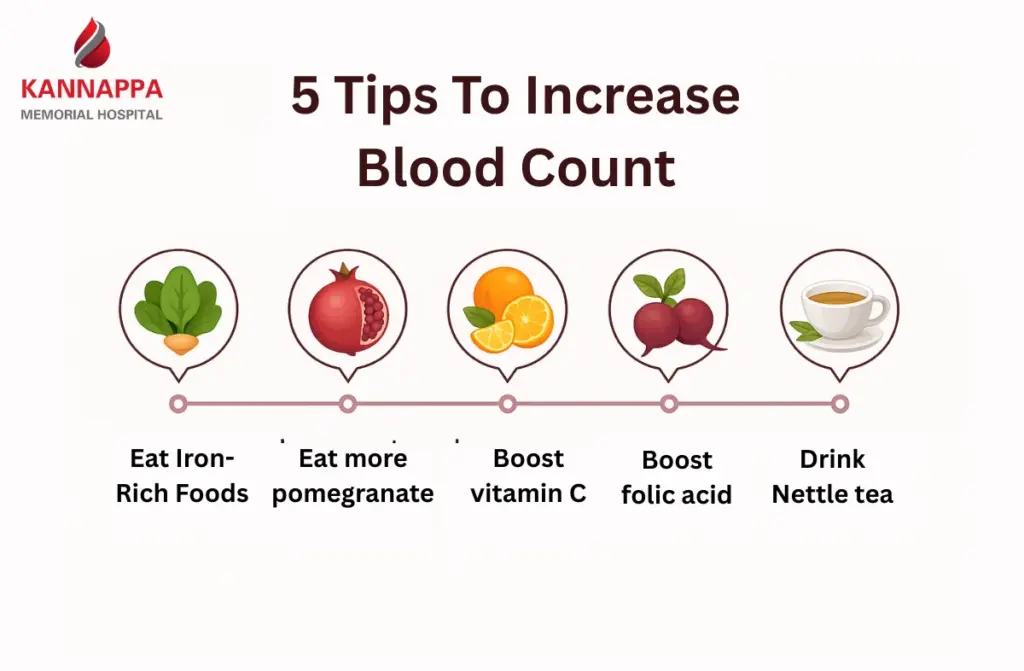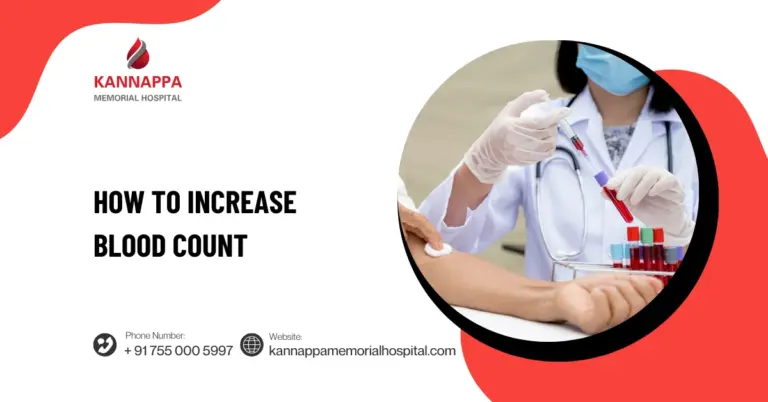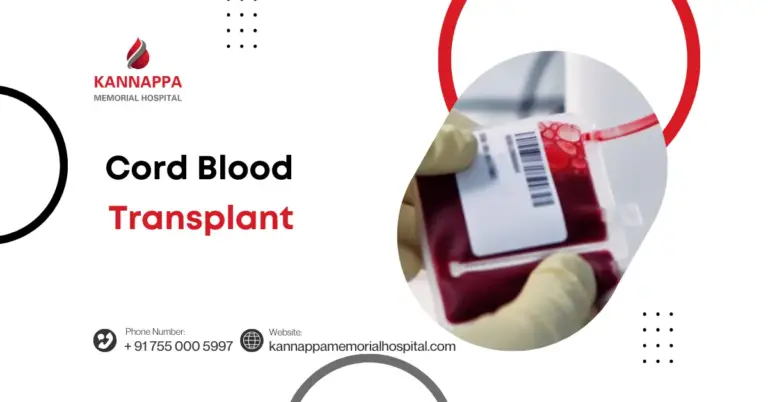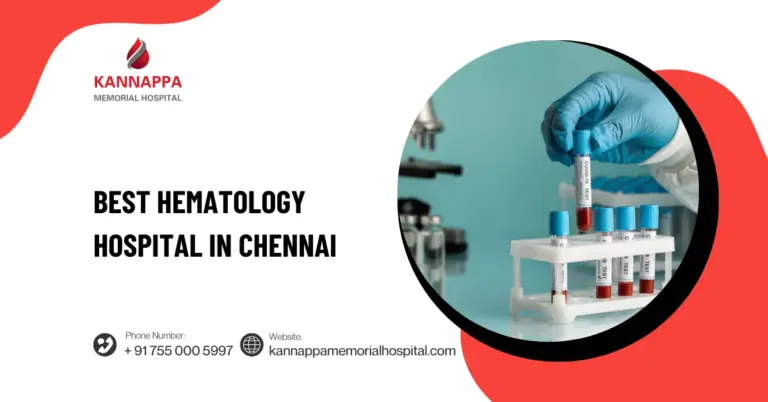An increase in blood count refers to the rise in the number of red blood cells, white blood cells, or platelets circulating in the bloodstream. These components play vital roles in oxygen transport, immune defense, and blood clotting. When levels drop below normal, it can lead to fatigue, infections, or excessive bleeding. Understanding how to increase blood count is essential for maintaining overall health and preventing complications related to anemia or immune deficiency. Various lifestyle changes, dietary adjustments, and medical interventions can support this goal.
What is Haemoglobin?
Haemoglobin is an essential iron-rich protein found in red blood cells that plays a crucial role in transporting oxygen from the lungs to the body’s tissues and carrying carbon dioxide back to the lungs for exhalation. It gives blood its red color and directly affects the oxygen-carrying capacity of the bloodstream.
- To increase blood count naturally, a diet rich in iron, folic acid, and vitamin B12 is vital. Foods such as leafy greens, lentils, red meat, and fortified cereals support the production of haemoglobin and healthy red blood cells.
- If you’re looking for how to increase low red blood cell count, focus on nutrients that boost erythropoiesis (red blood cell production), such as vitamin A, copper, and iron. Ensuring hydration and addressing any underlying medical conditions like anemia or chronic inflammation is also important.
- Understanding how to increase blood platelet count involves consuming foods high in vitamin C and K, such as citrus fruits, broccoli, and papaya, which support platelet production and function. Avoiding alcohol and managing infections or autoimmune conditions can further aid in maintaining healthy platelet levels.

What are the Signs and Symptoms of Low Haemoglobin?
Low haemoglobin levels affect the body’s ability to transport oxygen efficiently, leading to noticeable physical and cognitive symptoms. Recognizing these early warning signs is important for identifying underlying deficiencies and determining how to increase blood count effectively.
- Persistent Fatigue and Weakness: One of the most common symptoms is a constant feeling of tiredness, even after adequate rest. This results from insufficient oxygen delivery to the muscles and brain, affecting energy levels and daily functioning.
- Shortness of Breath: Individuals with low haemoglobin often experience breathlessness during light activities, such as walking or climbing stairs. This occurs because the lungs and heart must work harder to compensate for reduced oxygen-carrying capacity.
- Pale or Yellowish Skin: A noticeable paleness, especially in the face, lips, or nail beds, may indicate low red blood cell levels. In some cases, jaundice-like yellowing may also appear due to rapid breakdown of abnormal red blood cells.
- Headaches and Dizziness: Decreased oxygen supply to the brain can lead to frequent headaches, light-headedness, or even fainting. These symptoms signal poor cerebral oxygenation and may worsen with physical exertion.
- Cold Hands and Feet: Poor circulation due to reduced red blood cell count can result in consistently cold extremities. This symptom is often seen in conjunction with numbness or tingling sensations and may require attention to how to increase low red blood cell count naturally.
- Irregular Heartbeat or Chest Pain: The heart may beat faster or irregularly as it tries to pump more blood to deliver sufficient oxygen. This strain can be particularly concerning in older adults or those with existing cardiovascular conditions, and may also affect overall blood platelet function.
- Cognitive Issues and Difficulty Concentrating: A lack of oxygen reaching brain tissues can impair memory, focus, and decision-making abilities. These neurological effects highlight the importance of maintaining a healthy blood count for mental clarity and function.
What Causes Low Haemoglobin?
Low haemoglobin levels, known as anemia, can result from various factors that interfere with red blood cell production, increase destruction of red cells, or cause blood loss. Identifying the underlying cause is essential to effectively manage the condition and understand how to increase blood count.
- Nutritional Deficiencies: Deficiencies in iron, vitamin B12, and folate are among the most common causes of low haemoglobin. These nutrients are crucial for red blood cell synthesis, and their absence directly reduces the body’s ability to produce sufficient haemoglobin, often leading to fatigue and weakness.
- Chronic Blood Loss: Prolonged blood loss from conditions like heavy menstruation, gastrointestinal bleeding, ulcers, or haemorrhoids can significantly lower haemoglobin levels. This ongoing loss depletes iron stores and reduces red blood cell count over time, often requiring medical evaluation and iron supplementation.
- Chronic Diseases and Inflammation: Conditions such as chronic kidney disease, cancer, or autoimmune disorders can suppress the bone marrow’s ability to produce red blood cells. These disorders also interfere with erythropoietin, a hormone needed to stimulate red blood cell production, making it harder to increase low red blood cell count naturally.
- Bone Marrow Disorders: Diseases affecting the bone marrow, such as leukemia, aplastic anemia, or myelodysplastic syndromes, can impair the body’s capacity to form red and white blood cells, as well as platelets. This contributes not only to low haemoglobin but may also impact how to increase blood platelet count effectively.
- Infections and Certain Medications: Long-term infections or medications like chemotherapy drugs, antiretrovirals, or some antibiotics can damage bone marrow or interfere with red blood cell formation. These factors reduce blood count and may necessitate tailored nutritional or pharmacologic interventions.
- Inherited Blood Conditions: Genetic disorders such as sickle cell anemia or thalassemia affect haemoglobin structure or production. These conditions often require lifelong monitoring and therapeutic strategies to maintain functional haemoglobin and blood cell levels.
What Functions Does Haemoglobin Perform in Our Bodies?
Haemoglobin (Hb) is the powerhouse protein inside red blood cells that keeps tissues alive and chemistry stable. Its three core jobs are oxygen delivery, carbon-dioxide removal, and pH buffering—each one essential for energy, brain function, and endurance.
Oxygen transport
- Pickup in lungs, drop-off in tissues: Each Hb molecule binds oxygen in the alveoli where oxygen pressure is high and releases it in muscles and organs where it’s low. This reversible binding is why you can sprint, think clearly, and heal effectively.
- Smart release via the Bohr effect: Warmer, more acidic, high-CO₂ tissues make Hb let go of oxygen faster, so working muscles get priority. 2,3-BPG inside red cells also loosens Hb’s grip, improving delivery at altitude, during fever, or intense exercise.
- Why counts matter: Low Hb or too few red cells means less oxygen cargo per heartbeat, causing fatigue, dizziness, and breathlessness. If you’re exploring how to increase blood count or how to increase low red blood cell count, addressing iron/B12/folate gaps and underlying inflammation is foundational.
Carbon dioxide transport
- Multiple pathways out: CO₂ travels dissolved in plasma, converted to bicarbonate inside red cells, and bound to Hb as carbaminohemoglobin. Hb’s CO₂ carrying helps prevent dangerous buildup during rest and exertion.
- The Haldane effect = efficient unloading: When Hb grabs oxygen in the lungs, it releases CO₂ and hydrogen ions more readily, speeding waste removal. This lungs-to-tissues handoff keeps ventilation efficient and blood gases in balance.
- Clinical relevance: In anaemia, even normal lungs can struggle to clear CO₂ during exertion because total Hb cargo space is reduced. Optimizing red cell mass improves both oxygen delivery and CO₂ clearance.
Buffering role
- pH bodyguard: Hb soaks up hydrogen ions generated when CO₂ becomes carbonic acid, helping keep blood pH tightly between ~7.35–7.45. Deoxygenated Hb buffers even better, stabilizing chemistry during exercise or illness.
- Interlock with oxygen delivery: Buffering isn’t separate from transport—the Bohr and Haldane effects link pH control with oxygen/CO₂ exchange. When buffering is compromised (severe anaemia), fatigue and acidosis symptoms can intensify.
- System-wide impact: Stable pH protects enzyme function, cardiac rhythm, and brain signaling. Adequate Hb is therefore not just about “energy”; it’s about keeping every organ’s chemistry in the safe zone.
What is the Normal Haemoglobin Range?
Haemoglobin levels can vary depending on age, sex, and overall health. Maintaining levels within the normal range is essential for efficient oxygen delivery and overall well-being, as both low and high levels can indicate underlying health concerns.
Normal Haemoglobin Ranges:
- Men and Women: In adult men, the normal haemoglobin range is typically between 13.8 to 17.2 grams per decilitre (g/dL), while for adult women, it ranges from 12.1 to 15.1 g/dL. These values ensure adequate oxygen transport throughout the body and support healthy energy levels.
- Children and Infants: In children, normal levels generally range from 11 to 16 g/dL, while newborns can have levels as high as 17 to 22 g/dL shortly after birth. These values gradually adjust as t
- Factors Influencing Levels: Haemoglobin levels may be influenced by factors such as altitude, hydration status, pregnancy, and chronic illness. Regular monitoring can help detect deviations early and guide interventions if necessary.
- Improving Low Levels Naturally: If haemoglobin is below the normal range, understanding how to increase red blood cell count naturally becomes important. Iron-rich foods like lean meat, beans, and pumpkin seeds, along with vitamin C to enhance absorption, are beneficial.
- Supporting Overall Blood Count: Strategies on how to increase blood count also include incorporating foods high in folate and he child grows and their red blood cell production stabilizes.
B-complex vitamins, which are essential for red blood cell maturation and DNA synthesis. - Addressing Persistent Low Counts: Those seeking how to increase low red blood cell count should also ensure they are not dealing with hidden conditions such as gastrointestinal bleeding, chronic kidney disease, or bone marrow disorders, which can suppress red cell production.
How Do I Increase My Hemoglobin?
Raising haemoglobin levels involves supporting red blood cell production, improving iron absorption, and addressing any underlying health conditions that may interfere with the body’s ability to maintain healthy blood levels. A targeted approach combining diet, lifestyle changes, and medical evaluation is often most effective.
- Consume Iron-Rich Foods: Iron is the core component of haemoglobin, so incorporating iron-rich foods like red meat, poultry, tofu, lentils, spinach, and fortified grains is essential. Pairing these with vitamin C sources such as citrus fruits or bell peppers enhances iron absorption in the digestive tract.
- Increase Folate and Vitamin B12 Intake: Folate and B12 are vital for DNA synthesis and the formation of healthy red blood cells. Eggs, dairy, leafy greens, legumes, and fortified cereals support the body’s ability to increase blood count and correct low haemoglobin levels.
- Improve Platelet and Blood Health with Antioxidants: Those looking at how to increase blood platelet count should include foods rich in antioxidants and vitamin K, such as broccoli, kiwi, and pumpkin. These nutrients help stabilize platelet levels and support the function of bone marrow, where blood cells are produced.
- Avoid Iron Blockers and Increase Nutrient Bioavailability: Limit substances that reduce iron absorption, such as excessive caffeine, calcium supplements taken with meals, or high-fiber foods consumed at the same time as iron-rich meals. Enhancing nutrient bioavailability helps improve haemoglobin faster and more effectively.
- Stay Hydrated and Physically Active: Adequate water intake supports proper blood volume, and regular moderate exercise stimulates erythropoietin production—a hormone that signals the bone marrow to create more red blood cells. This contributes directly to how to increase low red blood cell count efficiently.
- Address Underlying Medical Issues: Persistent low haemoglobin may result from conditions like chronic kidney disease, internal bleeding, or autoimmune disorders. Medical diagnosis and appropriate treatment are essential in cases where lifestyle and dietary changes alone are not sufficient.
5 Nutrients that May Increase Red Blood Cell Counts
A well-balanced intake of specific nutrients plays a central role in supporting the body’s ability to produce healthy red blood cells. These nutrients are essential for those exploring how to increase red blood cell count naturally and maintain overall blood health.
- Iron: Iron is the foundational mineral required for haemoglobin synthesis and red blood cell production. Heme iron from animal sources like liver and red meat is highly absorbable, while non-heme iron from plant sources such as legumes and spinach should be paired with vitamin C to enhance absorption.
- Folate (Vitamin B9): Folate supports the formation of red blood cell precursors in the bone marrow and prevents certain types of anemia. Leafy greens, citrus fruits, lentils, and fortified cereals are rich sources that help increase blood count and support cellular health.
- Vitamin B12: This vitamin is crucial for DNA synthesis and proper maturation of red blood cells. Found in animal products such as eggs, fish, and dairy, B12 is especially important for those at risk of deficiency, including older adults and people with absorption issues.
- Vitamin A: Vitamin A helps mobilize iron from storage sites and supports the development of red blood cells in the bone marrow. Carrots, sweet potatoes, and dark green vegetables are excellent sources that assist in improving how to increase low red blood cell count.
- Copper: Copper works closely with iron to form haemoglobin and plays a role in iron metabolism. Foods like nuts, seeds, shellfish, and whole grains contribute to better red blood cell formation and overall improvement in how to increase blood count naturally.
8 Supplements that May Increase Red Blood Cell Counts
Supplements can be effective in addressing nutritional gaps and supporting the body’s natural process of red blood cell and platelet production. They are especially helpful for individuals with deficiencies or increased physiological demands related to how to increase blood count or improve overall hematologic health.
- Iron Supplements: Iron supplementation is commonly prescribed for iron-deficiency anemia and is essential for boosting haemoglobin production. Ferrous sulfate is one of the most frequently used forms, though it should be taken under supervision to avoid side effects like constipation or iron overload.
- Folic Acid (Vitamin B9): Folic acid supplements support the development of new red blood cells and prevent folate-deficiency anemia. This is especially useful for individuals with digestive disorders or increased folate needs, such as pregnant women.
- Vitamin B12: For those with absorption issues or dietary limitations, B12 supplements—oral or injectable—prevent megaloblastic anemia and support how to increase red blood cell count naturally by ensuring proper maturation in bone marrow.
- Vitamin C: While not directly involved in red blood cell production, vitamin C enhances iron absorption in the gut. Taking it alongside iron supplements boosts the effectiveness of iron therapy and helps improve blood count.
- Vitamin A: Supplementing with vitamin A can correct deficiencies that hinder iron utilization and red blood cell development. It also plays a regulatory role in immune health and supports how to increase blood platelet count through bone marrow support.
- Copper Supplements: Copper aids in iron metabolism and haemoglobin synthesis. Supplementation may benefit those with copper deficiency-induced anemia, particularly in individuals with malabsorption syndromes or after gastric surgery.
- Vitamin E: Known for its antioxidant properties, vitamin E protects red blood cells from oxidative damage. In certain cases, it may support how to increase blood count by stabilizing cell membranes and promoting red cell longevity.
- L-Carnitine: L-Carnitine supports energy metabolism and blood formation—both useful in strategies for how to increase red blood cell count naturally with balanced nutrition.
Conclusion
Improving blood count involves a comprehensive approach that includes proper nutrition, regular monitoring, and addressing any underlying medical issues. Key nutrients such as iron, folate, vitamin B12, and vitamin C support healthy red blood cell production, while lifestyle habits like moderate exercise and hydration further enhance blood formation and circulation.
For those seeking how to increase red blood cell count naturally, focusing on a balanced diet, reducing alcohol intake, and maintaining overall wellness are essential strategies for sustained improvement. Recognizing symptoms of low haemoglobin early allows for timely intervention and helps prevent complications affecting oxygen delivery and energy levels. This is especially important for individuals with Blood Disorders, where maintaining optimal blood count is critical for managing the condition effectively.
Read Also: Best Blood Cancer Hospital in Chennai











